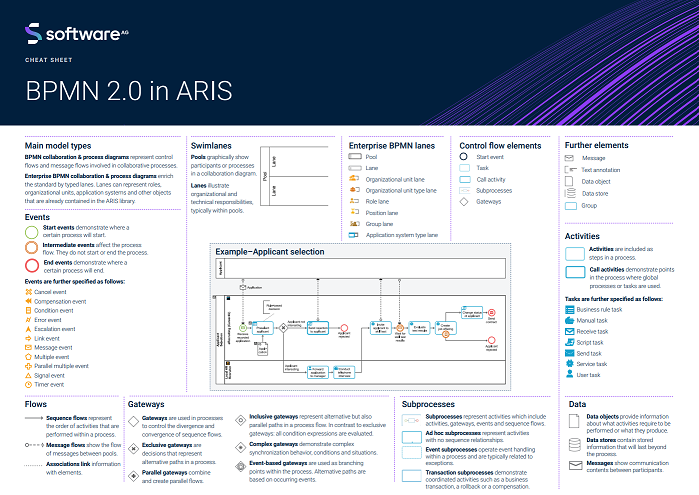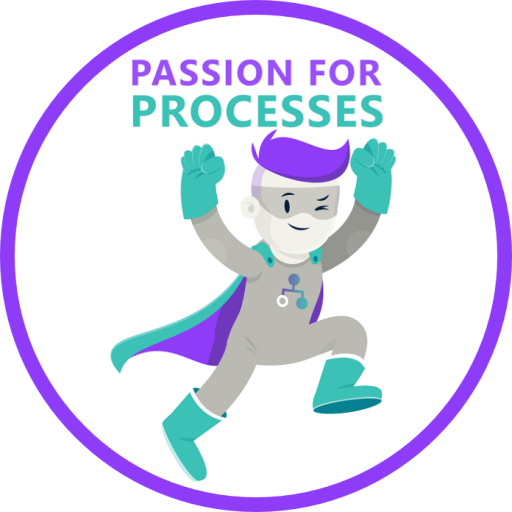
First of all a big applause for ARIS: ARIS is now a BPMN 2.0 leader! As one of only three tools, ARIS was able to successfully submit the entire test set of the BPMN Model Interchange Working Group (MIWG) and showed strong capabilities for importing, exporting and roundtripping (http://bpmn-miwg.github.io/bpmn-miwg-tools/).
If you want to read more about the validation and the BPMN 2.0 support in ARIS, I encourage you to read the article "If BPMN 2.0 then BPMN 2.0 in ARIS please!".
BPMN 2.0 in ARIS is unique. Of course ARIS supports the BPMN 2.0 standards. That’s one thing. But ARIS is more than BPMN 2.0 standard. It extends the standard with the business perspective and that what makes it so powerful. Sounds exciting but with so many possibilities do you fear losing track? No worries!
We created a fresh, new BPMN 2.0 in ARIS cheat sheet. You’ll find all important entities and their explanations, including symbols in one single view. We’ve packed it into a handy pdf format which you can download and print to reuse as cheat sheet. The cheat sheet covers all major aspects from model types, lane types, events, gateways, processes, flows, activities and data. It is the perfect guide to help you with the modeling. Click on the picture to enlarge it and download the pdf document.
You think it's good? Then be nice today and share it with your colleagues. I’m sure they will be grateful ;)
ARIS does not only offer great BPMN 2.0 support, ARIS adds DMN 1.2 support with ARIS 10 SR6 in October 2018 – being one of the first worldwide! – and encompasses BPMN modeling into the ARIS process landscapes. Using the process hierarchy und repository of ARIS, you can describe your enterprise from the strategic perspective down to the execution level.
We will go into this in more details and give you some useful tips in our next article – stay tuned!
useful sheet, just a couple of questions/clarification requests:
1. What's a 'cancel' event - not familiar with name or symbol from BPMN 2.0
2. Gateways - see a generic description against the blank gateway, but blank and XOR are used the same aren't they? ... just use one or the other. Also they don't make decisions do they - they just check the decision from previous activity, i.e. could label the gateway 'applicant interesting?' - with yes/no flows, but the actual activity that determines that is 'preselect applicant' ?
3... general question really ... personally do you prefer BPMN to EPC? ... do you use just one or both?
Charlie, happy to read, that your find the BPMN cheat sheet useful! Let me try to answer your questions:
- A cancel event must be attached to the boundary of a Sub-Process. It shall be triggered if an end event in a transaction sub-process is reached of if a cancel message has been received while a transaction is being performed. There is no non-interrupting version of this event.
- You're absolutely right: Blank is used equally to XOR. And it's also correct, that the decision is typically made by an activity before the gateway.
- From my perspective, it depends on the use case and the personal preferences whether to use BPMN or EPC - both have pros and cons. E. g. while the EPC is very good to read and many business-related satellites can be used directly in the model, the BPMN states an international, well-known and wide-spread standard, which can also be interpreted by common workflow execution engines. Some people also prefer the lane visualization, and thus, use a lane EPC instead of the vertical one. Another aspect might also be the level of detail - i.e. some people use EPC for level 4 processes, while they use BPMN for level 5 (which are intended to be automated). Finally, it depends ;-)
Best regards, Tom
Thanks Tom,much appreciated. With regards 3. - I was expecting 'it depends' :-) I think my concern with using EPC and one level and BPMN at another is that modellers - if responsibility to document at both levels, using different notations - may get a bit confusing ... as you say though 'it depends'. Thanks again.
Hi Charlie, I found a good explanation by Bruce Silver that is worth to read, see https://methodandstyle.com/bpmn-message/.
To put it in a nutshell: "The message is just the content of the communication, i.e. the information communicated. The communication itself is a message flow, a dashed connector in the diagram"
The usage of message objects or not has a strong semantic in executable diagrams. In non-executable diagrams it depends on the personal preference. There are message flows, which are self-explanatory without any text or message, for example when the source is a pool called 'Customer', and the target is a start event called "Customer has a problem'. When a specific document must be used for the conversation, then I would use a message object, for example 'Permit A38' would be worth to model it out :-)
Best regards, Sascha









